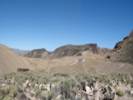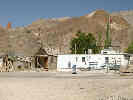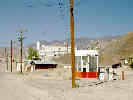
|
Originally published by the Nevada Native Plant Society (http://www.nvnps.org/) as Barneby, Rupert C., 1977. William H. Shockley: An early day mining engineer and exceptional plant collector. Mentzelia, 3: 19. Re-published on my web site with the permission of the Nevada Native Plant Society.
|
|
Literature Cited:
- Barneby, Rupert C., 1977.
Other articles:
• Field Notes:
5-Jun-06 in Candelaria;
• Mono Lake Basin Flora:
Seaside Heliotrope;
• Candelaria Road:
Candelaria;
• Seaside Heliotrope:
3;
Locations:
Candelaria.
|

Panorama of Candelaria |

Esmeralda Bank Building in Candelaria. |
William Hillman Shockley, one of the first botanical collectors actually to reside in,
rather than merely pass through the state of Nevada, lived for 13 years (1880-1893) at Candelaria, at that time a flourishing mining community situated close to the Esmeralda-Mineral county line. He was born in 1855 in New Bedford, Mass.; the family was of Pilgrim stock, claiming descent from John Alden. Shockley was educated in New England, graduating in 1875 from Massachusettes Institute of Technology with a degree in engineering, and shortly afterward emigrated to the western frontier to make his fortune in the Nevada silver mines. A man of wide culture and diverse interests, Shockley became interested in botany at an early age. Prior to his move west he had collected ferns in the limestone sinks around Ocala, Florida, which are mentioned in D.C. Eaton's Ferns of North America.
|
|
Other articles:
• Field Notes:
26-May-04;
26-May-04;
• Nevada Highway 265:
at Silver Peak;
Locations:
Silver Peak.
Sodaville.
 Silver Peak Silver Peak
|

Silver Peak |
Shockley's plant collecting in Nevada was the pursuit of such leisure hours as he could afford from his work in the mining firm of Shockley & Zabriskie at Candelaria. The majority of his plants were found on the wide valley floors and desert mountains within a short radius of Candelaria itself and around the springs and playas of the immediate vicinity. Ninety years ago the scene of Shockley's travels in Nevada was virgin territory for a botanist and in consequence a high portion of the plants, even though some are now known to be widespread in the Great Basin or southern deserts, were then new to science. Such were Oreocarya shockleyi Eastw., shrubby Lepidospartum squamatum A. Gray, two annuals — Lupinus shockleyi S. Wats. and Eriogonum esmeraldense S.Wats., the glaucous desert columbine — Aquilegia shockleyi Eastw., rare Arabis shockleyi Munz, and the small-fruiting form of Astragalus serenoi (Kuntze) Sheldon that has been described as A. shockleyi M.E. Jones. Candelaria is the type locality given for his collection of Lycium shockleyi A. Gray and Eriogonum shockleyi S. Wats. Two remarkable composites, Acamptopappus shockleyi A. Gray and the monotypic genus Hecastocleis, were among his more notable prizes. Gray listed Candelaria as the type locality for these two composites, but according to Abrams and Ferris (1960) Shockley said he collected Hecastocleis shockleyi at Silver Peak, Esmeralda Co. Sodaville (Soda Springs) is only 11 airline miles from Candelaria and Shockley collected some very interesting plants there (see page 11). Shockley's rediscovery of Oryctes nevadensis S. Wats., still imperfectly known from poor material collected on Clarence King's expedition in 1867, enabled Gray to formulate a complete description of this unique solanceous genus.
|
|
Locations:
White Mountains.
|
In 1886 and again in 1888 Shockley was in the White Mountains across the California border, climbing in both seasons to timberline, where he encountered, among others, Draba subsessilis S. Wats., D. breweri S. Wats., Penstemon shockleyi S. Wats., Eriogonum gracilipes S. Wats., Silene shockleyi S. Wats., and Ivesia shockleyi S. Wats., all of which were described, wholly or in part, from his collection.
|
|
|
By modern standards Shockley's collections were small. He sent one set of specimens to Harvard, where they were studied and named by Asa Gray and Sereno Watson. Duplicates of some of these are to be found in the herbaria at Pomona College, Claremont; at California Academy of Sciences, San Francisco; at the Greene Herbarium, Notre Dame; and at New York Botanical Garden. Shockley's private herbarium, said to be the most complete set, is at University of California, Berkeley.
|
|
|
Shockley married May Bradford in 1908. On retirement they settled in southern California. Shockley died in Los Angeles, May 26, 1925.
|
|
|
A very few of the species named for Shockley have been reduced to synonomy, but they still serve as reminders of the zeal of this amateur collector. There is less visible evidence of Candelaria's existence as a booming mining town, today only a few crumbling stone walls remain in the lonely desert canyon.
|
|
If you have a question or a comment you may write to me at:
tomas@schweich.com
I sometimes post interesting questions in my FAQ, but I never disclose your full name or address.
|
[Home Page] [Site Map]
Date and time this article was prepared:
5/12/2025 2:41:30 PM
|
 Eastern Mojave Vegetation
Eastern Mojave Vegetation
 Eastern Mojave Vegetation
Eastern Mojave Vegetation
